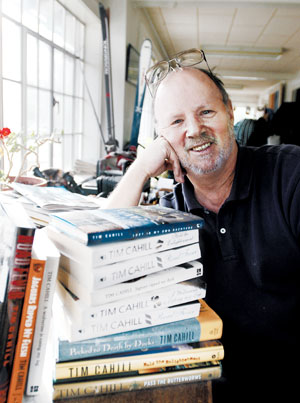THROUGHOUT his decades of travel writing, Tim Cahill has traipsed to the ends of the earth and back. His books include Pecked to Death by Ducks, Hold the Enlightenment, Lost in My Own Backyard and Road Fever.
In that last one, Cahill teams up with professional long-distance driver Garry Sowerby and motors from the tip of South America to Prudhoe Bay, Alaska, in less than 24 days.
When it comes to magazine work, Cahill was one of the founding editors of Outside, originally a spin-off from Rolling Stone in the ’70s. Now 66, Cahill is safely setting up shop in San Jose’s Naglee Park neighborhood while he spends the semester teaching at San Jose State University as the Lurie Distinguished Visiting Writer.
Although Cahill is predominantly known for adventure travel books, he first had to write a serial-killer book in order to crack the big publishing houses. Back in 1986, Buried Dreams: Inside the Mind of a Serial Killer was Cahill’s debut, a ghoulish 370-page journey through the psyche of the Killer Clown, Mr. Gacy himself.
“I spent three years in the mind of John Wayne Gacy,” Cahill tells me. “And when I came swimming out of it, I said, ‘I never want to do that again.’ It was much more healthy and wholesome psychologically to do the work I’m doing now. … That first book was a national bestseller, which allowed me to write travel books. Once you have a national bestseller, they pretty much let you write whatever you want to write. It’s interesting that the serial-killer book is the only one of mine that’s out of print.”
In his classes at SJSU, Cahill says that he is trying to teach students that, above all else, the writing is what matters. The “travel” part is secondary: “What I do is just say, ‘This is what you have to do to write a story that moves the reader, either to laughter or tears, hopefully both, in the same piece.’ What I’m trying to teach them is what works and what doesn’t work in nonfiction. The travel part isn’t necessary; the writing part is the necessary part.”
The best travel writing emerges from people who are writers to begin with but who just happen to travel at length and who desire the unknown. It doesn’t come from bloggers who decide to go on a trip and then post about all the things they saw. In fact, legends like Paul Theroux, Bill Bryson, and Jan Morris tend to bristle when categorized solely as travel writers. Instead, they are “writers who travel.”
Cahill says the best stories must include the mishaps. “In good travel writing,” he tells me, “something on the trip always has to go wrong. That’s the one rule I usually go by. That’s what makes a good story. Something has to go wrong.”
Since what passes for travel writing these days has degenerated so rapidly in just the last few years, no one knows what will happen. Currently, anyone who goes on a trip and produces fluffy passages simply rehashing their itinerary now calls it “travel writing.”
Anyone who writes a service blurb about 400-thread-count French sateen linens at whichever Ritz-Carlton recently comped them a stay now refers to herself as “press” or “media” or “travel journalist.” When the going gets mediocre, the mediocre turn pro.
“We’re learning that there’s going to be a whole new paradigm for what travel writing is all about,” Cahill says. “The kind of literary travel writing that I favor is not the sort of thing that we necessarily get on travel blogs—I’m not saying all of them, but most of them. The whole profession is in a state of flux right now. There’s a kind of hunger out there for literate, well-written travel stories, but it’s not being fulfilled consistently in any place that I see right now.”
TIM CAHILL @ SJSU Center for Literary Arts
• April 28
• Martin Luther King Jr.
Library, San Jose
• Conversation at 1pm
• Reading at 7pm
•Free



